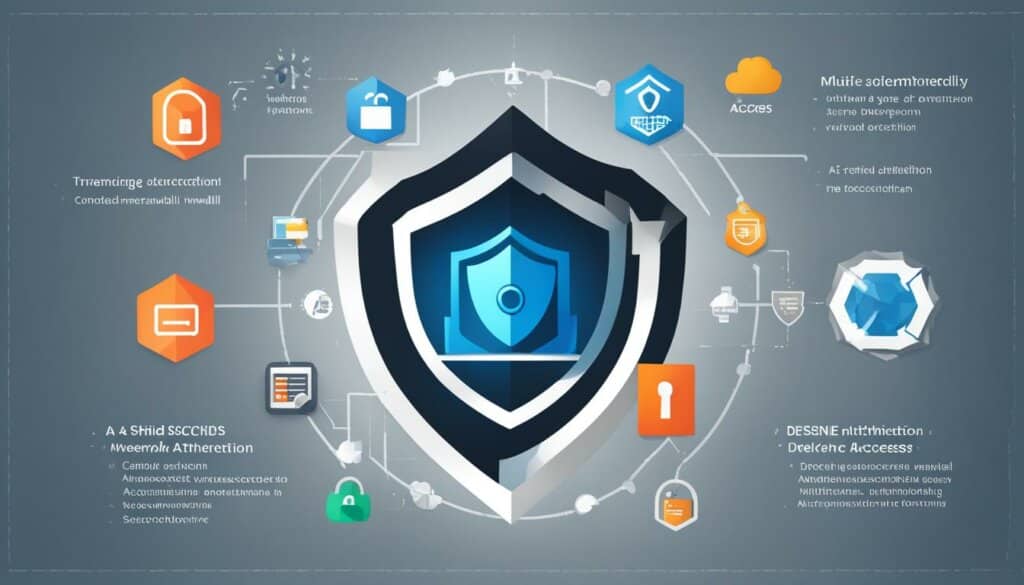Table of Contents
Cybersecurity is a critical aspect of protecting your valuable data from various threats. By implementing the right data security best practices and following essential cybersecurity tips, you can ensure the safety of your sensitive information. In this article, we will explore effective data protection strategies and highlight the importance of adopting cybersecurity best practices.
With the ever-evolving threat landscape, data breaches have become increasingly costly for organizations. It is crucial to have robust data security measures in place to safeguard your data and mitigate potential risks. By implementing cybersecurity best practices, you can minimize the chances of data breaches and protect your organization from reputational damage, financial losses, and legal liabilities.
To help you navigate the complex world of data security, we will cover a range of topics in this article. From understanding the significance of data security to identifying the data that requires protection, we will provide detailed insights into the key principles and controls for securing sensitive data. We will also discuss the top 10 data security best practices that every organization should follow.
Furthermore, we will delve into different data technologies and databases, exploring their benefits and challenges. Additionally, we will discuss the global cybersecurity trends that are expected to shape the landscape in 2023. Lastly, we will emphasize the importance of a people-centric approach to cybersecurity, focusing on employee education, access control measures, and password management.
Throughout this article, we will provide you with valuable information and actionable strategies to enhance your data protection efforts. By adopting cybersecurity best practices, you can safeguard your organization’s sensitive data and ensure a strong defense against potential threats.
Understanding the Significance of Data Security
Data security plays a crucial role in safeguarding an organization’s sensitive assets and maintaining the trust of customers and stakeholders. With the increasing prevalence of data breaches in today’s digital landscape, organizations need to prioritize robust data security measures to protect valuable information. By implementing effective data security practices, businesses can mitigate the risk of a data breach and enjoy several important benefits.
One of the key benefits of data security is the protection of information from unauthorized access. By implementing measures such as encryption and access control, organizations can ensure that only authorized individuals have access to sensitive data. This helps prevent data breaches and protects valuable intellectual property, trade secrets, and customer information.
Data security also strengthens an organization’s reputation. In the event of a data breach, a company’s credibility and trustworthiness can be significantly damaged. By prioritizing data security, organizations demonstrate their commitment to protecting customer and employee information, enhancing their reputation as a responsible and trustworthy entity.
Furthermore, compliance with data protection laws and regulations is essential for businesses operating in today’s global landscape. By implementing robust data security measures, organizations can ensure they are in compliance with relevant data protection requirements, avoiding potential legal and financial consequences. Additionally, strong data security practices contribute to reducing litigation expenses that may result from data breaches.
In summary, data security is of paramount importance in today’s digital world. By implementing robust data security measures, organizations can protect sensitive information, strengthen their reputation, comply with data protection laws, reduce legal expenses, and enhance business continuity.
Identifying Data Requiring Protection
In today’s digital landscape, organizations must be vigilant in protecting sensitive data to comply with data protection laws and safeguard financial data, personal data, and protected health information.
Financial data, such as bank account details and credit card information, is a prime target for cybercriminals seeking financial gain. Data breaches involving financial data can have severe consequences, including financial loss for individuals and damage to an organization’s reputation. Compliance with data protection laws, such as the General Data Protection Regulation (GDPR) in the UK, is essential for safeguarding financial data and ensuring accountability.
Personal data, including names, addresses, and social security numbers, is another type of information that requires protection. Cybercriminals often target personal data to commit identity theft or engage in fraudulent activities. Data protection laws, such as the Data Protection Act 2018 in the UK, provide guidelines on handling and securing personal data to protect individuals’ privacy.
Sensitive Data Requiring Protection:
- Financial data (e.g., bank account details, credit card information)
- Personal data (e.g., names, addresses, social security numbers)
- Protected health information (e.g., medical records, health insurance information)
Protected health information, including medical records and health insurance information, requires robust protection to ensure patient confidentiality and comply with healthcare regulations, such as the Health Insurance Portability and Accountability Act (HIPAA) in the US. Breaches of protected health information can not only lead to legal repercussions but also compromise patient trust in healthcare organizations.
By understanding the types of data that require protection and the relevant laws and regulations governing their security, organizations can proactively implement measures to prevent data breaches and safeguard sensitive information.
Understanding Key Threats to Corporate Data
In today’s digital landscape, organizations face numerous threats to the security of their data. Understanding these threats is crucial for implementing effective data security measures. In this section, we will explore the different types of threats that organizations encounter, including human threats, insider threats, cyber attacks, and supply chain attacks.
Human threats are one of the most common and significant data security risks. These can include human errors, negligence, or intentional actions that compromise data integrity and confidentiality. For example, an employee accidentally sending sensitive information to the wrong recipient or a disgruntled employee deliberately leaking confidential data.
“Human threats are often a result of insufficient employee training on data security best practices and a lack of awareness about the potential consequences of their actions.”
Insider threats pose an additional challenge to data security. These threats involve employees or individuals with authorized access to an organization’s systems and data who intentionally misuse or abuse their privileges. Insider threats can result in unauthorized data access, data theft, or sabotage.
Cyber attacks are another significant threat to corporate data. These attacks involve malicious actors attempting to gain unauthorized access to an organization’s systems or networks for malicious purposes. Common cyber attacks include phishing, malware infections, ransomware attacks, and Distributed Denial of Service (DDoS) attacks.
Lastly, supply chain attacks have gained prominence in recent years. These attacks target an organization’s vendors, suppliers, or partners to gain access to the target organization’s systems or data. By exploiting weaknesses in the supply chain, attackers can infiltrate an organization’s network and steal or manipulate sensitive data.
Table: Types of Data Security Threats
| Type of Threat | Description |
|---|---|
| Human Threats | Threats caused by human errors, negligence, or intentional actions that compromise data integrity and confidentiality. |
| Insider Threats | Threats posed by employees or authorized individuals who misuse or abuse their privileges to gain unauthorized access to data. |
| Cyber Attacks | Malicious activities carried out by external actors, targeting an organization’s systems or networks for malicious purposes. |
| Supply Chain Attacks | Attacks that exploit vulnerabilities in an organization’s supply chain to gain unauthorized access to systems or data. |
By understanding these key threats to corporate data, organizations can develop comprehensive data security strategies to protect against potential breaches and mitigate the associated risks. In the following sections, we will explore essential methods for securing sensitive data and the core principles and controls for data security.

Essential Methods for Securing Sensitive Data
Securing sensitive data is crucial for organizations to protect their valuable assets and maintain data integrity. There are several essential methods that organizations can employ to ensure data security.
Encryption: One of the most effective methods of securing sensitive data is through encryption. By encrypting data, it is transformed into unreadable text that can only be decrypted using a specific key. This ensures that even if unauthorized individuals gain access to the data, they would not be able to make sense of it.
Masking: Another method is data masking, which involves replacing sensitive data with fictional or scrambled values. This allows organizations to use realistic-looking data for testing and development purposes, without exposing the actual sensitive information.
Data Erasure: Properly erasing data from storage devices is critical to prevent unauthorized access. This method involves permanently deleting data in a way that it cannot be recovered. Secure data erasure methods include overwriting data with random patterns and physically destroying storage media.
Data Resilience: Data resilience refers to the ability of data to remain secure and accessible even in the face of system failures or malicious attacks. This involves implementing backup and disaster recovery mechanisms to ensure data availability and integrity.
| Method | Description |
|---|---|
| Encryption | Transforms data into unreadable text that can only be decrypted with a specific key |
| Masking | Replaces sensitive data with fictional or scrambled values for testing and development purposes |
| Data Erasure | Permanently deletes data from storage devices to prevent unauthorized access |
| Data Resilience | Ensures data remains secure and accessible even in the face of system failures or attacks |
Core Principles and Controls for Data Security
In today’s digital landscape, ensuring the confidentiality, integrity, and availability of sensitive data is of utmost importance. Organizations must implement robust data security controls to protect against various threats and maintain the trust of their stakeholders. Understanding the core principles of data security is crucial in establishing a strong defense against potential breaches.
The Core Principles of Data Security
Confidentiality, integrity, and availability form the foundation of data security. Confidentiality ensures that data is accessible only to authorized individuals or systems. It involves implementing access controls, encryption, and secure transmission protocols to protect sensitive information from unauthorized disclosure or theft.
Integrity focuses on maintaining the accuracy and consistency of data throughout its lifecycle. It involves the implementation of measures such as data validation, checksums, and error correction to prevent unauthorized modifications or tampering.
Availability ensures that data is accessible to authorized users when needed. It involves implementing data backup and recovery strategies, redundancy measures, and robust infrastructure to minimize downtime and ensure seamless access to data.
Data Security Controls
Data security controls are the specific measures and practices that organizations implement to safeguard their sensitive data. These controls include:
- Access controls: Implementing measures such as strong authentication, role-based access controls, and least privilege principles to ensure that only authorized individuals can access sensitive data.
- Encryption: Encrypting data both at rest and in transit to protect it from unauthorized access. This involves using strong encryption algorithms and key management practices.
- Monitoring and logging: Implementing robust monitoring systems and logging mechanisms to detect and respond to security incidents in real-time.
- Incident response: Having a well-defined incident response plan that outlines the steps to be taken in the event of a data breach or security incident.
- Data classification: Categorizing data based on its sensitivity and implementing appropriate security controls based on the classification.
By following these core principles and implementing data security controls, organizations can mitigate the risks associated with data breaches and ensure the protection of sensitive information.
| Data Security Principle | Description |
|---|---|
| Confidentiality | Ensuring that data is accessible only to authorized individuals or systems through measures such as access controls and encryption. |
| Integrity | Maintaining the accuracy and consistency of data throughout its lifecycle by implementing data validation and error correction mechanisms. |
| Availability | Ensuring that data is accessible to authorized users when needed through data backup and recovery strategies. |
Top 10 Data Security Best Practices
Implementing effective data security best practices is crucial for organizations to safeguard their sensitive information and protect against potential data breaches. By following these top 10 best practices, organizations can enhance their data security posture and mitigate security risks:
1. Define Sensitive Data
Start by identifying what constitutes sensitive data within your organization. This includes personally identifiable information (PII), financial data, intellectual property, and any other data that, if compromised, could harm individuals or the organization.
2. Establish a Cybersecurity Policy
Create a comprehensive cybersecurity policy that outlines the guidelines and procedures for protecting data. This policy should cover data classification, access controls, encryption, incident response, and employee responsibilities for data security.
3. Develop an Incident Response Plan
Prepare a well-defined incident response plan to efficiently respond to any data security incidents. This plan should include steps for identifying, reporting, containing, and mitigating the impact of a security incident, as well as guidelines for communication and recovery.
4. Ensure Secure Data Storage
Securely store sensitive data using encryption and access control mechanisms. Consider implementing secure storage solutions such as data encryption at rest and in transit, using industry-standard encryption algorithms, and robust access control policies.
5. Limit User Access
Implement strong user access management practices by granting access to sensitive data on a need-to-know basis. Use role-based access controls (RBAC) and two-factor authentication (2FA) to ensure that only authorized individuals can access sensitive information.
6. Continuously Monitor User Activity
Implement user activity monitoring solutions to track user behavior and detect any suspicious activities. Regularly review access logs, monitor data transfers, and analyze user behavior patterns to identify any potential insider threats or unauthorized access attempts.
7. Manage Third-Party Risks
Assess the security posture of third-party vendors and service providers who have access to your organization’s data. Conduct due diligence and perform regular audits to ensure that they adhere to data security best practices and comply with relevant regulations.
8. Pay Attention to Privileged Users
Implement strict controls and monitoring mechanisms for privileged users who have elevated access to sensitive data. Regularly review and update their access rights, monitor their activity, and enforce strong password policies to reduce the risk of insider threats.
9. Educate Employees on Data Security Risks
Train employees on data security best practices and raise awareness about the risks associated with data breaches. Provide regular training sessions, conduct simulated phishing exercises, and establish clear guidelines for handling sensitive data to foster a culture of security within the organization.
10. Deploy Dedicated Data Security Software
Invest in data security software solutions that can enhance your organization’s data protection capabilities. This includes deploying robust antivirus and anti-malware solutions, intrusion detection and prevention systems, and data loss prevention tools.

| Best Practice | Description |
|---|---|
| Define Sensitive Data | Identify and categorize the types of data that require protection. |
| Establish a Cybersecurity Policy | Create a comprehensive policy that outlines guidelines and procedures for data protection. |
| Develop an Incident Response Plan | Prepare a plan to effectively respond to data security incidents. |
| Ensure Secure Data Storage | Implement encryption and access controls to securely store sensitive data. |
| Limit User Access | Grant access to sensitive data on a need-to-know basis. |
| Continuously Monitor User Activity | Track user behavior and detect any suspicious activities. |
| Manage Third-Party Risks | Assess the security posture of third-party vendors and service providers. |
| Pay Attention to Privileged Users | Implement strict controls and monitoring mechanisms for privileged users. |
| Educate Employees on Data Security Risks | Train employees and raise awareness about data security risks. |
| Deploy Dedicated Data Security Software | Invest in software solutions to enhance data protection capabilities. |
Understanding Data Technologies and Databases
In today’s digital landscape, understanding data technologies and databases is vital for organizations seeking to manage and process vast amounts of information effectively. From traditional relational databases to modern NoSQL solutions, each technology offers unique features and advantages that cater to specific business needs.
Relational databases, such as SQL (Structured Query Language), have been the industry standard for many years. They store information in tables with rows and columns, enabling efficient data retrieval and manipulation. SQL databases excel in managing structured data, making them ideal for applications with well-defined data schemas. They provide robust ACID (Atomicity, Consistency, Isolation, Durability) properties, ensuring data integrity and reliability.
On the other hand, NoSQL databases break away from the rigid structure of SQL databases and offer more flexibility in handling unstructured, semi-structured, and polystructured data. They are highly scalable and designed to manage vast amounts of data, making them suitable for applications dealing with big data and real-time data processing. NoSQL databases, such as MongoDB and Cassandra, provide high availability and horizontal scalability, allowing organizations to adapt to changing data needs effortlessly.
Relational databases excel in managing structured data, while NoSQL databases offer flexibility for unstructured and big data.
Comparing SQL and NoSQL Databases
To help you better understand the differences between SQL and NoSQL databases, let’s take a closer look at some key aspects:
| Aspect | SQL Databases | NoSQL Databases |
|---|---|---|
| Data Model | Fixed schema | Flexible schema |
| Query Language | SQL | Non-SQL or specialized query languages |
| Scalability | Vertical scaling | Horizontal scaling |
| Data Consistency | Strong consistency | Eventual consistency |
| Use Cases | Transaction processing, complex queries | Big data, real-time analytics |
Both SQL and NoSQL databases have their strengths and suitability for different scenarios. Organizations must evaluate their specific requirements, such as data structure, scalability needs, and data consistency, to determine which type of database best meets their needs.

Managing Big Data and File Systems
The exponential growth of data has led to the emergence of big data management technologies and practices. Big data refers to datasets that are too large and complex for traditional data processing applications to handle. To effectively analyze big data, organizations often employ distributed file systems, such as Apache Hadoop, which divide data into smaller chunks and distribute them across multiple servers for parallel processing.
File systems play a crucial role in managing unstructured data, such as documents, images, and videos. They provide hierarchical organization and storage for files, ensuring easy access, retrieval, and sharing. Examples of file systems include NTFS (New Technology File System) for Windows and ext4 for Linux.
By understanding data technologies and databases, organizations can make informed decisions about the right solutions to adopt for managing and leveraging their valuable data assets.
Global Cybersecurity Trends for 2023
As cyber threats continue to evolve, it is crucial for organizations to stay ahead of the curve and adopt proactive measures to protect their digital assets. In this section, we explore the key global cybersecurity trends that are expected to shape the landscape in 2023. By understanding these trends, organizations can better prepare themselves and implement effective strategies to mitigate risks.
Rise in Cloud Security
Cloud computing has become an integral part of modern business operations, offering scalability, flexibility, and cost-efficiency. However, it also poses unique challenges in terms of data security. In 2023, we can expect to see a significant focus on strengthening cloud security measures. Organizations will invest in advanced encryption techniques, multi-factor authentication, and robust access controls to safeguard their data in the cloud. Additionally, with the adoption of hybrid and multi-cloud environments, organizations will prioritize the implementation of comprehensive cloud security frameworks to ensure data integrity and protection.
Zero Trust Architecture
Zero Trust is an emerging cybersecurity concept that challenges the traditional perimeter-based approach to security. In a Zero Trust architecture, organizations assume that no user or device can be trusted, regardless of their location or network. Instead, access to resources is granted on a need-to-know basis and continuously monitored for potential threats. In 2023, we will see an increased adoption of Zero Trust principles, especially in combination with Virtual Private Networks (VPNs), to provide a more robust and secure network environment. This approach will help organizations detect and contain potential breaches, limiting the impact of cyber threats.
Strengthening Supply Chain Security
The recent surge in supply chain attacks has highlighted the vulnerability of interconnected systems. In response, organizations will place greater emphasis on supply chain security in 2023. This will involve implementing stringent vetting processes for third-party vendors, conducting regular security assessments, and establishing clear contractual obligations regarding data security. By taking a proactive approach to supply chain security, organizations can minimize the risk of compromise and ensure the integrity of their products and services.
Enhanced Cybersecurity Compliance
Cybersecurity regulations and compliance requirements are becoming more stringent worldwide. In 2023, organizations will focus on aligning their cybersecurity practices with these evolving regulatory frameworks. This will involve regular audits, risk assessments, and the implementation of robust cybersecurity policies and procedures. Organizations will also invest in technologies and solutions that facilitate compliance monitoring and reporting. By prioritizing cybersecurity compliance, organizations can demonstrate their commitment to protecting sensitive data and prevent potential legal and financial repercussions.
| Trend | Description |
|---|---|
| Cloud Security | Increased focus on securing data in cloud environments with advanced encryption, multi-factor authentication, and robust access controls. |
| Zero Trust Architecture | Adoption of Zero Trust principles, combined with VPNs, to create a more secure network environment by granting access on a need-to-know basis. |
| Supply Chain Security | Strengthening vetting processes for third-party vendors and establishing clear contractual obligations to minimize the risk of supply chain compromise. |
| Cybersecurity Compliance | Focusing on aligning cybersecurity practices with evolving regulatory frameworks through audits, risk assessments, and robust policies and procedures. |
People-Centric Approach to Cybersecurity
In today’s digital landscape, organizations must adopt a people-centric approach to cybersecurity to effectively protect their sensitive data. While robust technical measures are essential, educating employees and raising awareness about cybersecurity risks is equally important. By investing in employee education and awareness programs, organizations can empower their workforce to become the first line of defense against cyber threats.
Access control is another key aspect of a people-centric approach to cybersecurity. By implementing strong access control measures, organizations can restrict user permissions based on job roles and responsibilities. This helps minimize the risk of unauthorized access to sensitive data and reduces the likelihood of data breaches.
Effective password management is crucial for maintaining data security. Employees should be educated on the importance of creating strong, unique passwords and using multi-factor authentication when available. Regular password updates and the use of password managers can further enhance the security of sensitive accounts and information.

Overall, a people-centric approach to cybersecurity acknowledges the role of employees as active participants in data protection. By equipping them with the knowledge and tools to identify and respond to potential threats, organizations can create a culture of security awareness and enhance their overall cybersecurity posture.
Key Considerations for a People-Centric Approach to Cybersecurity
- Invest in ongoing employee education and awareness programs to keep employees informed about emerging threats and best practices for data protection.
- Implement strong access control measures to ensure that only authorized personnel have access to sensitive data.
- Encourage the use of strong, unique passwords and enable multi-factor authentication to enhance the security of user accounts.
- Regularly update and patch software and systems to defend against known vulnerabilities.
- Monitor and audit user activity to detect any suspicious behavior or unauthorized access attempts.
Conclusion
In conclusion, adopting cybersecurity best practices is crucial for organizations to safeguard their sensitive data and protect against potential threats. By implementing robust data protection measures, businesses can mitigate the risks of data breaches and ensure the confidentiality, integrity, and availability of their valuable information.
Throughout this article, we have highlighted the significance of data security, identified the types of data that require protection, and discussed the key threats to corporate data. We have also explored essential methods for securing sensitive data and discussed the core principles and controls for data security.
Furthermore, we have outlined the top 10 data security best practices, emphasized the need for a people-centric approach to cybersecurity, and provided insights into global cybersecurity trends for 2023. By following these recommendations, organizations can enhance their overall data security posture and effectively mitigate potential risks.
Remember, data protection is an ongoing process, and organizations must remain vigilant in implementing and maintaining cybersecurity best practices. By staying abreast of emerging technologies, new threats, and evolving regulations, businesses can stay ahead of cybercriminals and ensure the long-term security of their sensitive data.
FAQ
What are some data security best practices for protecting sensitive information?
Some data security best practices include defining sensitive data, establishing a cybersecurity policy, building an incident response plan, ensuring secure data storage, limiting access to critical assets, continuously monitoring user activity, managing third-party risks, paying attention to privileged users, educating employees on data security risks, and deploying dedicated data security software.
What types of data require protection and what laws govern their protection?
Financial data, personal data, and protected health information are examples of data that require protection. Their protection is governed by relevant data protection laws, standards, and regulations.
What are some key threats organizations face in terms of data security?
Organizations face threats such as human errors, negligence, and malicious insiders. They also face external threats like cyberattacks and supply chain attacks.
What methods can be used to secure sensitive data?
Some methods of securing sensitive data include encryption, masking, data erasure, and data resilience. These methods help prevent unauthorized access, protect data integrity, and ensure data availability.
What are the core principles of data security?
The core principles of data security are confidentiality, integrity, and availability. These principles form the basis of strong data protection.
What are some data security best practices that organizations should follow?
Organizations should follow best practices such as defining sensitive data, establishing a cybersecurity policy, building an incident response plan, ensuring secure data storage, limiting access to critical assets, continuously monitoring user activity, managing third-party risks, paying attention to privileged users, educating employees on data security risks, and deploying dedicated data security software.
What are the different types of data technologies and databases?
The different types of data technologies and databases include relational databases, NoSQL databases, and file systems for storing unstructured data.
What are some global cybersecurity trends to expect in 2023?
Some global cybersecurity trends to expect in 2023 include developing cloud security measures, implementing zero trust in combination with a VPN, augmenting supply chain infrastructure, complying with stricter cybersecurity requirements, and embracing threat detection and response tools.
How can organizations adopt a people-centric approach to cybersecurity?
Organizations can adopt a people-centric approach to cybersecurity by focusing on employee education and awareness, implementing access control measures, effective password management, securing remote work environments, and managing privileged access.
What is the importance of adopting cybersecurity best practices for data protection?
Adopting cybersecurity best practices for data protection is important to safeguard sensitive information, strengthen reputation, comply with data security requirements, reduce litigation expenses, and enhance business continuity.
Source Links
- https://www.netwrix.com/data_security_best_practices.html
- https://www.ekransystem.com/en/blog/data-security-best-practices
- https://www.ekransystem.com/en/blog/best-cyber-security-practices













